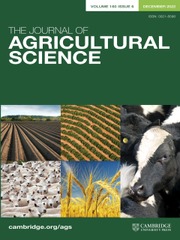No CrossRef data available.
Article contents
Growth analysis of cassava genotypes planted under irrigation management practices during the early growth phase
Published online by Cambridge University Press: 12 December 2024
Abstract
New information on the growth analysis for different cassava genotypes grown under different irrigation managements during the early growth phase could support decision-making to improve crop productivity. This study aimed to determine the performance of 20 cassava genotypes grown under different irrigation management practices during the early growth phase. A strip-plot design with four replications was used during two growing seasons (2019/2020 and 2020/2021). Three levels of irrigation from 30 to 180 days after planting (DAP) were assigned as factor A (W1 = 100%, W2 = 60% and W3 = 20% of the crop water requirement), whereas 20 cassava genotypes were assigned as factor B. Crop data were recorded on SPAD chlorophyll meter reading (SCMR), specific leaf area (SLA) and leaf area index (LAI) at 180 and 330 DAP, relative growth rate (RGR) from 180 to 330 DAP and harvest index (HI) at 330 DAP. The genotypes CMR36-31-381 and Huay Bong 90 had high values of HI, indicating a good partitioning of photosynthate to the storage root. These two genotypes also showed superior performances in terms of SCMR, SLA and RGR inW2 and W3 treatments when compared to the other genotypes. They also had LAI values within the optimum range during the period of maximum canopy size. Therefore, the genotypes CMR36-31-381 and Huay Bong 90 could be used as genetic resources to improve cassava productivity under different irrigation levels.
- Type
- Crops and Soils Research Paper
- Information
- Copyright
- Copyright © The Author(s), 2024. Published by Cambridge University Press



